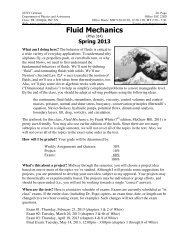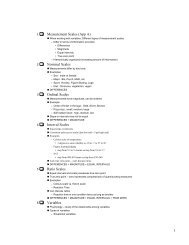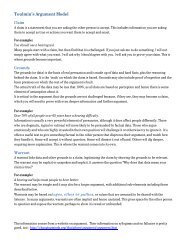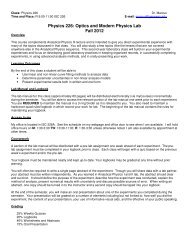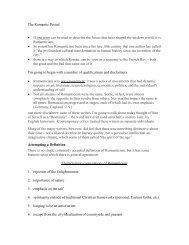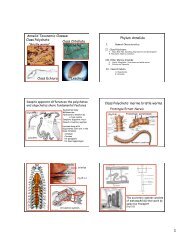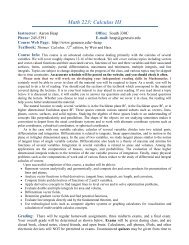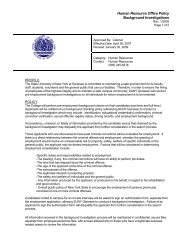Math 333 - Practice Exam 2 with Some Solutions
Math 333 - Practice Exam 2 with Some Solutions
Math 333 - Practice Exam 2 with Some Solutions
Create successful ePaper yourself
Turn your PDF publications into a flip-book with our unique Google optimized e-Paper software.
<strong>Math</strong> <strong>333</strong> - <strong>Practice</strong> <strong>Exam</strong> 2 <strong>with</strong> <strong>Some</strong> <strong>Solutions</strong><br />
(Note that the exam will NOT be this long.)<br />
1 Definitions<br />
1. (0 points) Let T : V → W be a transformation. Let A be a square matrix.<br />
(a) Define “T is linear”.<br />
(b) Define the null space of T , null(T ).<br />
(c) Define the image of T , image(T ).<br />
(d) Define “T is one-to-one”.<br />
(e) Define “T is onto”.<br />
(f) Define “T is invertible”.<br />
(g) Define “T is an isomorphism”.<br />
(h) Define rank(T ) and nullity(T ).<br />
(i) Define “A is invertible”.<br />
Solution: See your notes or textbook.<br />
1
2 Linear Transformations, Null Spaces, and Images<br />
2. (0 points) Let T : P 2 (R) → P 2 (R) be given by T (f(x)) = f(x) − xf ′ (x).<br />
(a) Show T is linear.<br />
Solution: Let a ∈ R and f(x), g(x) ∈ P 2 (R). Then<br />
T (af(x) + g(x)) = [af(x) + g(x)] − x[af(x) + g(x)] ′<br />
= af(x) + g(x) − axf ′ (x) − xg ′ (x)<br />
= a[f(x) − xf ′ (x)] + [g(x) − xg ′ (x)]<br />
= aT (f(x)) + T (g(x)).<br />
(b) Find a basis for the image of T .<br />
Solution: We know that a generating set for the image of T is the image of the<br />
standard basis of P 2 (R). Thus<br />
image(T ) = span({T (1), T (x), T (x 2 )})<br />
= span({1, x − x, x 2 − 2x 2 })<br />
= span({1, −x 2 }).<br />
The vectors {1, −x 2 } are clearly linearly independent, so it will also be a basis.<br />
(c) Is T one-to-one? Is T onto? Justify your answer.<br />
Solution: Since rank(T ) = 2 and dim(P 2 (R)) = 3, T is clearly not onto. Furthermore,<br />
the Dimension Theorem says the nullity(T ) = 1, so T is not one-to-one<br />
either.<br />
2
3. (0 points) Let T : R 3 → R 3 be the linear transformation defined by<br />
T (x, y, z) = (x + y, x − z, 2x + 3y + z) .<br />
(a) Show T is linear.<br />
(b) Find a basis for null(T ).<br />
(c) Find a basis for image(T ).<br />
(d) State the Dimension Theorem and verify that T satisfies it.<br />
(e) Is T one-to-one? Onto? Explain.<br />
4. (0 points) Let V and W be finite-dimensional vector spaces and T : V → W be<br />
linear.<br />
(a) Prove that if dim(V ) < dim(W ), then T cannot be onto.<br />
Solution: Suppose dim(V ) < dim(W ), and assume (by means of contradiction) that<br />
T is onto. Then image(T ) = W , and thus rank(T ) = dim(W ). By the dimensions<br />
theorem, we know<br />
dim(V ) = rank(T ) + nullity(T )<br />
= dim(W ) + nullity(T )<br />
Since dim(V ) < dim(W ), this implies nullity(T ) = dim(V ) − dim(W ) < 0, which is<br />
a contradiction since nullity can not be negative. Thus T is NOT onto.<br />
(b) Prove that if dim(V ) > dim(W ), then T cannot be one-to-one.<br />
Solution: Similar argument to (a). See if you can get it.<br />
3
5. (0 points) Let T : V −→ W be a linear transformation. Prove the following<br />
theorems.<br />
(a) Theorem 2.1: The sets null(T ) and image(T ) are subspaces of V and W , respectively.<br />
(b) Theorem 2.2: Let β be a basis of V . Then the set {T (β)} is a generating set for<br />
image(T ).<br />
(c) Theorem 2.4: T is one-to-one if and only if null(T ) = {0}.<br />
Solution: See your notes or textbook.<br />
3 Matrix Representations and Change of Basis<br />
6. (0 points) Consider the vector space V = P 1 (R).<br />
(a) Explain why you know that the set β = {1 + x, 1 − 2x} is a basis of V .<br />
Solution: Since neither vector is a multiple of the other, β is linearly independent.<br />
Since the dimension of V is 2, β is a basis.<br />
(b) Determine [p(x)] β , where p(x) = 2x − 3 ∈ V .<br />
Solution: ( Notice that ) p(x) = 2x − 3 = (−4/3)(1 + x) + (−5/3)(1 − 2x). Therefore<br />
−4/3<br />
[p(x)] β =<br />
.<br />
−5/3<br />
7. (0 points) Let T : P 2 (R) −→ R 2 be given by T (f(x)) = (f(0), f ′ (1)).<br />
(a) Show that T is linear.<br />
Solution: Let f(x), g(x) ∈ P 2 (R) and c ∈ R. Then<br />
T (cf(x) + g(x)) = (cf(0) + g(0), cf ′ (1) + g ′ (1))<br />
= c(f(0), f ′ (1)) + (g(0), g ′ (1))<br />
= cT (f(x)) + T (g(x)).<br />
4
(b) Determine the matrix of T <strong>with</strong> respect to the standard bases of P 2 (R) and R 2 .<br />
Solution: First we recall that the standard basis of P 2 (R) is β = {1, x, x 2 } and that<br />
the standard basis of R 2 is γ = {(1, 0), (0, 1)}. Now we look at the image of each<br />
element of the basis β under T .<br />
T (1) = (1, 0), T (x) = (0, 1), and T (x 2 ) = (0, 2).<br />
Since we are using the standard basis of R 2 the columns of our matrix are the vectors<br />
we have just written. So our matrix is<br />
[T ] γ β = (<br />
1 0 0<br />
0 1 2<br />
)<br />
.<br />
8. (0 points) Let β and γ be the following standard ordered bases of M 2×2 (R) and<br />
P 2 (R), respectively:<br />
{( ) ( ) ( ) ( )}<br />
1 0 0 1 0 0 0 0<br />
β =<br />
, , ,<br />
and γ = {1, x, x 2 }.<br />
0 0 0 0 1 0 0 1<br />
Compute [T ] β γ if we define the linear transformation T : P 2 (R) −→ M 2×2 (R) by<br />
(<br />
)<br />
f ′ (0) 2f(1)<br />
T (f(x)) =<br />
.<br />
0 f ′′ (3)<br />
( )<br />
0 2<br />
Solution: First we see that T (1) = . So the first column of [T ] β γ is the coordinate<br />
vector [T (1)] β = (0, 2, 0, 0). Next T (x) = . So the second column of [T ] β γ<br />
0 0<br />
( )<br />
1 2<br />
0 0<br />
( )<br />
is the coordinate vector [T (x)] β = (1, 2, 0, 0). Finally T (x 2 0 2<br />
) = . So the third<br />
0 2<br />
column of [T ] β γ is the coordinate vector [T (x 2 )] β = (0, 2, 0, 2). So in total we get<br />
⎛ ⎞<br />
0 1 0<br />
[T ] β 2 2 2<br />
γ = ⎜ ⎟<br />
⎝ 0 0 0 ⎠<br />
0 0 2<br />
5
9. (0 points) Let V , W , and Z be vector spaces, and let T : V → W and U : W → Z<br />
be linear transformations.<br />
(a) Prove that if U ◦ T is one-to-one, then T is one-to-one.<br />
Solution: Suppose U ◦ T is one-to-one. Then null(U ◦ T ) = {0}. What is null(T )?<br />
Suppose x ∈ null(T ), then T (x) = 0 and (U ◦ T )(x) = U(T (x)) = U(0) = 0. So x<br />
is in null(U ◦ T ) also. But 0 is the only thing in null(U ◦ T ), so x = 0, and we have<br />
shown that null(T ) = {0}. Therefore T is one-to-one.<br />
(b) Prove that if U ◦ T is onto, then U is onto.<br />
Solution: Similar argument to (a). See if you can get it.<br />
(c) Prove that if U and T are one-to-one and onto, then U ◦ T is also<br />
Solution: Similar argument to (a). See if you can get it.<br />
10. (0 points) Let T : R 3 → R 2 be the linear transformation defined by<br />
T (x, y, z) = (x + y + z, x + 3y + 5z)<br />
Let β and γ be the standard bases for R 3 and R 2 respectively. Also consider another<br />
basis α = {(1, 1, 1), (2, 3, 4), (3, 4, 6)} for R 3 .<br />
(a) Compute the matrix representation [T ] γ β .<br />
(b) Compute the matrix representation [T ] γ α.<br />
(c) Compute Q the change of coordinate matrix from β to α.<br />
(d) Check that [T ] γ α · Q = [T ] γ β .<br />
(e) Let x = (1, 5, 7). What is [x] β ? Use this, together <strong>with</strong> Q, to find [x] α .<br />
6
Solution:<br />
(a) Plugging basis ( β into T)<br />
and writing as a linear combination of the elements of γ, we<br />
get [T ] γ β = 1 1 1<br />
.<br />
1 3 5<br />
(b) Plugging basis ( α into T and ) writing as a linear combination of the elements of γ, we<br />
get [T ] γ 3 9 13<br />
α =<br />
.<br />
9 31 45<br />
(c) To get the change of basis matrix, we must find the coordinate vectors of the elements<br />
of β <strong>with</strong> respect to α:<br />
⎛ ⎞<br />
2<br />
⎜<br />
[(1, 0, 0)] α = ⎝ −2<br />
1<br />
⎟<br />
⎠, [(0, 1, 0)] α =<br />
⎛<br />
⎜<br />
⎝<br />
Therefore the change of basis matrix is Q =<br />
(d) [T ] γ α · Q =<br />
(<br />
3 9 13<br />
9 31 45<br />
(e) x = (1, 5, 7) =⇒ [x] β =<br />
⎛<br />
⎜<br />
⎝<br />
) ⎛ ⎜ ⎝<br />
2 0 −1<br />
1<br />
5<br />
7<br />
⎞<br />
⎟<br />
⎠<br />
−2 3 −1<br />
1 −2 1<br />
0<br />
3<br />
−2<br />
⎛<br />
⎜<br />
⎝<br />
⎞<br />
⎟<br />
⎠ =<br />
⎛<br />
⎞ ⎛ ⎞<br />
2 0 −1 1<br />
⎜<br />
⎟ ⎜<br />
=⇒ [x] α = Q · [x] β = ⎝ −2 3 −1 ⎠ ⎝ 5<br />
1 −2 1 7<br />
⎞<br />
⎛<br />
⎟<br />
⎜<br />
⎠, and [(0, 0, 1)] α = ⎝<br />
2 0 −1<br />
−2 3 −1<br />
1 −2 1<br />
(<br />
⎟<br />
⎠ =<br />
1 1 1<br />
1 3 5<br />
⎛<br />
⎜<br />
⎝<br />
−5<br />
6<br />
−2<br />
⎞<br />
⎟<br />
⎠<br />
)<br />
⎞<br />
⎟<br />
⎠ .<br />
= [T ] γ β .<br />
−1<br />
−1<br />
1<br />
⎞<br />
⎟<br />
⎠.<br />
7



